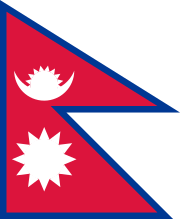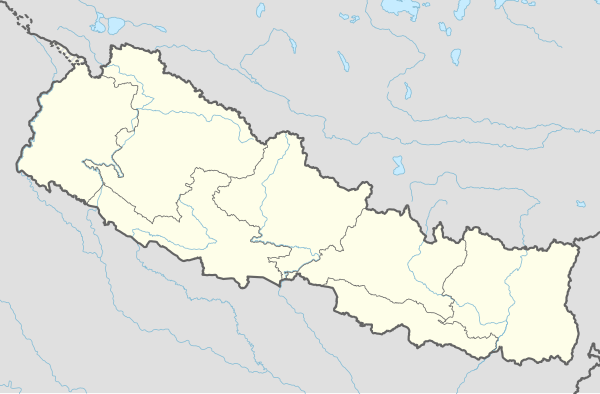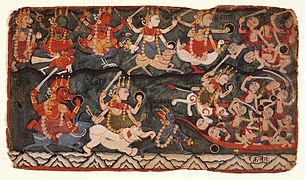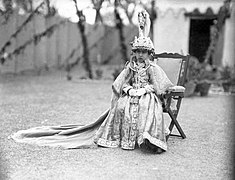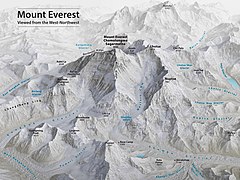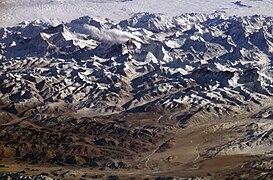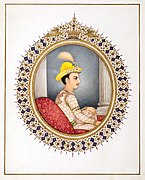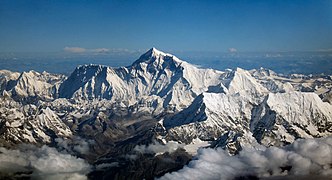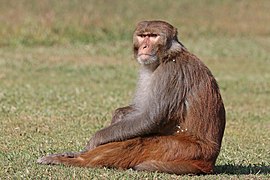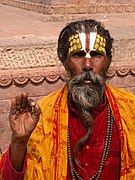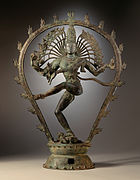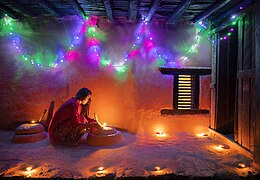स्वागतम् / Welcome to the Nepal Portal
The flag of Nepal Location on the world map Nepal Federal Democratic Republic of Nepal , is a landlocked country in South Asia . It is mainly situated in the Himalayas , but also includes parts of the Indo-Gangetic Plain . It borders the Tibet Autonomous Region of China to the north , and India to the south, east, and west , while it is narrowly separated from Bangladesh by the Siliguri Corridor , and from Bhutan by the Indian state of Sikkim . Nepal has a diverse geography , including fertile plains , subalpine forested hills, and eight of the world's ten tallest mountains , including Mount Everest , the highest point on Earth. Kathmandu is the nation's capital and the largest city . Nepal is a multi-ethnic, multi-lingual, multi-religious and multi-cultural state, with Nepali as the official language.
The name "Nepal" is first recorded in texts from the Vedic period of the Indian subcontinent , the era in ancient Nepal when Hinduism was founded, the predominant religion of the country. In the middle of the first millennium BC, Gautama Buddha , the founder of Buddhism , was born in Lumbini in southern Nepal. Parts of northern Nepal were intertwined with the culture of Tibet . The centrally located Kathmandu Valley is intertwined with the culture of Indo-Aryans , and was the seat of the prosperous Newar confederacy known as Nepal Mandala . The Himalayan branch of the ancient Silk Road was dominated by the valley's traders . The cosmopolitan region developed distinct traditional art and architecture . By the 18th century, the Gorkha Kingdom achieved the unification of Nepal . The Shah dynasty established the Kingdom of Nepal and later formed an alliance with the British Empire , under its Rana dynasty of premiers . The country was never colonised but served as a buffer state between Imperial China and British India . Parliamentary democracy was introduced in 1951 but was twice suspended by Nepalese monarchs, in 1960 and 2005. The Nepalese Civil War in the 1990s and early 2000s resulted in the establishment of a secular republic in 2008, ending the world's last Hindu monarchy.
The Constitution of Nepal , adopted in 2015, affirms the country as a secular federal parliamentary republic divided into seven provinces . Nepal was admitted to the United Nations in 1955, and friendship treaties were signed with India in 1950 and China in 1960. Nepal hosts the permanent secretariat of the South Asian Association for Regional Cooperation (SAARC), of which it is a founding member. Nepal is also a member of the Non-Aligned Movement and the Bay of Bengal Initiative . The Nepalese Armed Forces are the fifth-largest in South Asia; and are notable for their Gurkha history, particularly during the world wars , and have been a significant contributor to United Nations peacekeeping operations. (Full article...
Thank you For Visiting
More Did you know (auto generated)
Kathmandu Kathmandu Metropolitan City , is the capital and most populous city of Nepal with 845,767 inhabitants living in 105,649 households as of the 2021 Nepal census and approximately 4 million people in its urban agglomeration. It is located in the Kathmandu Valley , a large valley in the high plateaus in central Nepal, at an altitude of 1,400 metres (4,600 feet).
The city is one of the
oldest continuously inhabited places in the world , founded in the 2nd century AD. The valley was historically called the "
Nepal Mandala " and has been the home of the
Newar people , a cosmopolitan urban civilization in the
Himalayan foothills. The city was the royal capital of the
Kingdom of Nepal and hosts palaces, mansions and gardens built by the Nepali aristocracy. It has been home to the headquarters of the
South Asian Association for Regional Cooperation (
SAARC ) since 1985. Today, it is the seat of government of the Federal Democratic Republic of Nepal, established in 2008, and is part of
Bagmati Province . (
Full article... )
List of selected articles
Mount Everest , the highest peak on earth, lies on the Nepal-China border
Category puzzle Select [►] to view subcategories
CTC and Orthodox tea Nepali tea Camellia sinensis Nepal . They are distinctive in appearance, aroma and taste, but are similar in many ways to tea produced in Darjeeling tea , perhaps because the eastern zones of Nepal have geography and topography similar to Darjeeling. Its relatively smaller production quantities mean that teas from Nepal are less well known than those from Darjeeling.
Nepal's teas fall into two types of tea: Orthodox tea and
Crush, tear, curl tea. (
Full article... )
List of fare/cuisine articles
In Nepal there are as many as 80 ethnic groups speaking more than 100 different languages.
Dang Valley situated in the mid-western development region of Nepal is the largest valley of Asia.
The following pages at Wikimedia Commons contain a plethora of images taken in Nepal.
Wiki Loves Earth is an international photographic competition to promote natural heritage sites around the World through Wikimedia projects (mainly Wikipedia and Wikimedia Commons ).
Wiki Loves Monuments is an international photographic competition to promote cultural monuments around the World through Wikimedia projects (mainly Wikipedia and Wikimedia Commons.
Below is a clickable map of Nepal's Provinces
NEPAL
General images - show another The following are images from various Nepal-related articles on Wikipedia.
Forts Religious sites Other sites
World Heritage Sites Palaces Religious sites Municipal wise sites Kathmandu Other sites
Forts Religious sites Other sites
Sino-Tibetan
Indo-Aryan
Pahari Madheshi Newars
Over 25 distinct castes, major being Shresthas , Chathariya, Jyapu , Vajracharya , Rajopadhyaya Brahmins , Chitrakar , Khadgi, Manandhar, Dhobi , Pode, Ranjitkar , Mali , etc. Newar Muslim Indian Madheshi
Indo-Aryanof a distinct origin Other peoples (M , D , i )of Indus-Ganga Immigrants Other basis
Africa Americas Asia Europe Oceania International organizations Treaties Related topics
Existing Expressway Under construction
Rivers
Mahananda basin Sapta Koshi basin Bagmati basin Narayani basin Karnali basin
Lakes Glaciers Icefalls Dams, barrages Related topics
Official language Indigenous
Lists by Province Lists by former Zones
Africa Asia
Europe North America Oceania
National teams League system Domestic Cups Defunct
Clubs
A-Division B Division C Division Others
National parks Wildlife reserves Conservation areas Hunting reserves Ramsar sites
Indian Subcontinent
Other countries
Extended content
This is a list of recognized content, updated weekly by JL-Bot (talk · contribs ) (typically on Saturdays). There is no need to edit the list yourself. If an article is missing from the list, make sure it is tagged (e.g. {{ WikiProject Nepal }} ) or categorized correctly and wait for the next update. See WP:RECOG for configuration options.
Featured articles Good articles Featured pictures
An Iconic Photograph of 1990 Nepalese revolution
Ashta-Matrika
Bos grunniens at Letdar on Annapurna Circuit
Crowning Tribhuvan of Nepal (1911) (restoration)
Everest North Face toward Base Camp Tibet Luca Galuzzi 2006 edit 1
Everest-3D-Map-Type-EN
Head of Bhairava - MET DP307219
Himalayas, Ama Dablam, Nepal
Himalayas
Indian rhinoceros (Rhinoceros unicornis) 4
King Girvan Yuddhavikram Shah (1797-1816) (restoration)
Legal hashish shop in Kathmandu, Nepal in 1973
Milvus migrans -Kathmandu, Nepal-444
Mount Everest as seen from Drukair2 PLW edit
Pumori, Nepal, Asia
Rhesus macaque (Macaca mulatta mulatta), male, Gokarna
Sadou Kathmandu 04 04
Shiva as the Lord of Dance LACMA edit
Sir Chandra Shumsher Jang Bahadur Rana (restoration)
Sister lighting traditional lamp during Tihar festival (edited)








